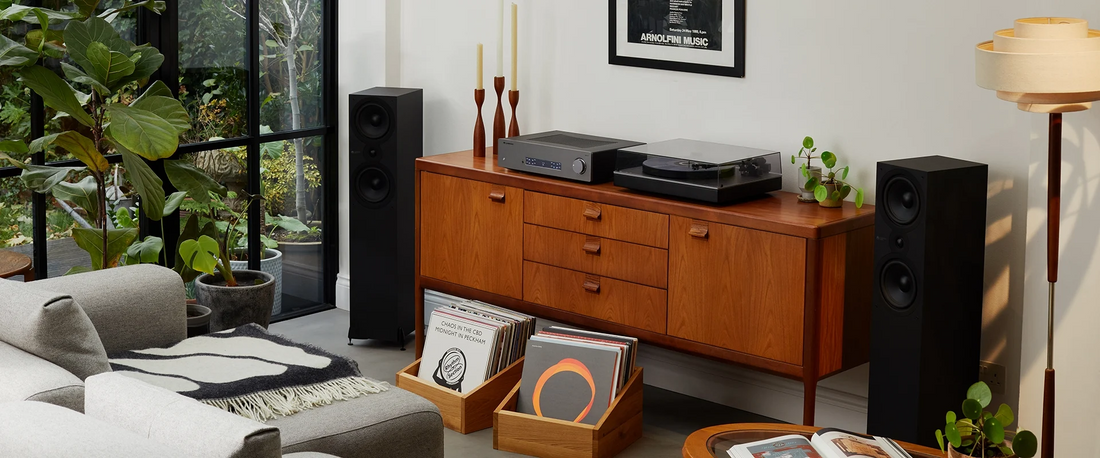
The best hifi I setup for your record player
Share
Headphone Amps and Preamps are terms that often get grouped together and can seem confusing to musicians and recording engineers. In reality, these devices both perform useful and individual functions.
Headphone amp vs. preamp – what’s the difference?
Preamps are used for three main purposes: selecting a sound source, controlling the dynamics, and adding gain. On the other hand, a headphone amp is specifically designed to power headphones. They are essentially volume controls.
These are the main differences between the two, but when we inspect more closely, it becomes apparent that headphone amps and preamps vary in many other ways.
Their power requirements, compatibility, and the effect they have on tone coloration are some of the distinct differences. After reading this comprehensive guide, you’ll know exactly what purposes both devices are best suited to and how they vary from each other.

The Main Differences Between Headphone Amps & Preamps
To understand the difference between headphone amps and preamps, we first must consider their purposes. Headphone amps are used specifically to boost the signal of a sound source to make it ideally suited to being played back through a pair of headphones.
Preamps are more complex. Preamps are primarily used for selecting a certain sound source using onboard controls and boosting the signal of the sound significantly so that it is compatible with a power amp or mixing controller. Preamps also offer multiple adjustable parameters for tweaking the characteristics of the sound.
Speaking from a technical standpoint, preamps and headphone amps differ greatly in terms of their power requirements and the load they are capable of driving.
Normally, preamp outputs are required to drive a much higher impedance load than headphone amps, because they are used with more powerful devices like monitors, mixing desks, and interfaces.
The table below shows an example of the differences in power requirements between the headphone amps and preamps.
| Headphone Amp | Preamp |
| · 30-50 Ohms drive load | · 10k-47k Ohms drive load |
| · A voltage level of 0.5 – 4V RMS | · A voltage level of around 1V RMS |
| · Requires strong output stage | · Relatively easy electric load |
| · Solely for volume control | · Includes volume & gain controls |
As you can see from this table, there are significant differences in the ways that headphone amps and preamps operate.
This is mainly due to the devices that preamps are commonly used with, which require certain impedance strength. The electronic requirements of headphones amps may vary depending on the type of headphone they are used with, but these numbers are accurate in the majority of cases.
Both of these devices are essentially used to control volume levels. When a musician is recording using headphones, it’s highly important that the levels are set to the optimal level depending on their preferences. It’s common that headphone amps allow the musician to tweak the dynamics of their instrument or the backing track.
Preamps go one step further and allow you to actually select from multiple sound sources.
Each sound source can then be adjusted using the volume controls, and some preamps also provide the possibility to add gain. By doing so, they can alter the coloration of the instrument or other sound sources to suit their preferences.
What Is A Headphone Amp Used For?
In the following section, we will take a closer look at headphone amps, and their purposes.
A headphone amp works in combination with a DAC (digital audio converter). These devices are responsible for converting the signal produced by a sound source into analog so that it can be received by the headphones.
An example of this would be if you were to plug some headphones directly into your phone or computer then play an audio file, the signal would be sent digitally, in the form of zeros and ones. A DAC then converts this into an analog format that the headphones are able to play.
So where do headphone amps come into the equation?
Well, on its own, a DAC doesn’t sufficiently boost the output signal so that it can be received by the headphones. It needs an extra boost, which is provided by a headphone amp.
At this point, it’s easy to see why people commonly confuse headphone amps with preamps, as the headphone amp does technically amplify the signal prior to it being sent to the output device.
Combining Headphone Amps and DACs
The main difference between a preamp and a headphone amp becomes apparent when we consider the sound card of a computer or laptop. In the majority of cases, sound cards combine the headphone amp with the DAC, which is why you can plug straight in and hear the audio file instantaneously.
Pretty much all computers produced today will have a combination of headphone amps and DACs onboard. They may facilitate headphone ports or dedicated outputs especially for speakers, but regardless of the medium you listen to the audio through, a headphone amp and DAW are almost certainly going to be used.
In some cases, it may be necessary to use external, standalone DACs. However, this alone would not provide enough amplification to the signal for it to be played through headphones, so a headphone amp would be required too.
